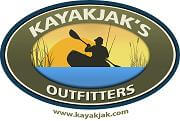2022 Recap:
This was my final year as an educator retiring after 40 years of service. Traveling was inconsistent this year but still managed some major accomplishments. A top 10 national finish culminated a season of challenges that kept me from achieving many of my goals. My fish catching goal was 2022 and I met that as well catching 2,034 fish. I also caught my personal best smallmouth bass and that was on Barkley Lake in Tennessee going 20.75 inches. Also, caught a 20+ smallmouth on Wilson Lake in Kansas.
Kayak Fishing Competition Results 2022
1st Place Central States Series Carter Lake
2nd Place Central States Series #2 Elwood Lake
Kayakjak’s Major League Fishing AOY 2022
Top 10 AOY Central States Series (8th)
7th Place KBF Challenge Series Championship (Tennessee)
7th Place KBF National Championship 7 of 249 (Tennessee)
5th Place KBF National Challenge Championship of 1,270 anglers
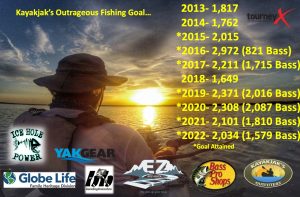
Author Archives: Marty
Recap of 2022 Fishing Season
2022 Recap:
This was my final year as an educator retiring after 40 years of service. Traveling was inconsistent this year but still managed some major accomplishments. A top 10 national finish culminated a season of challenges that kept me from achieving many of my goals. My fish catching goal was 2022 and I met that as well catching 2,034 fish. I also caught my personal best smallmouth bass and that was on Barkley Lake in Tennessee going 20.75 inches. Also, caught a 20+ smallmouth on Wilson Lake in Kansas.
Kayak Fishing Competition Results 2022
1st Place Central States Series Carter Lake
2nd Place Central States Series #2 Elwood Lake
Kayakjak’s Major League Fishing AOY 2022
Top 10 AOY Central States Series (8th)
7th Place KBF Challenge Series Championship (Tennessee)
7th Place KBF National Championship 7 of 249 (Tennessee)
5th Place KBF National Challenge Championship of 1,270 anglers
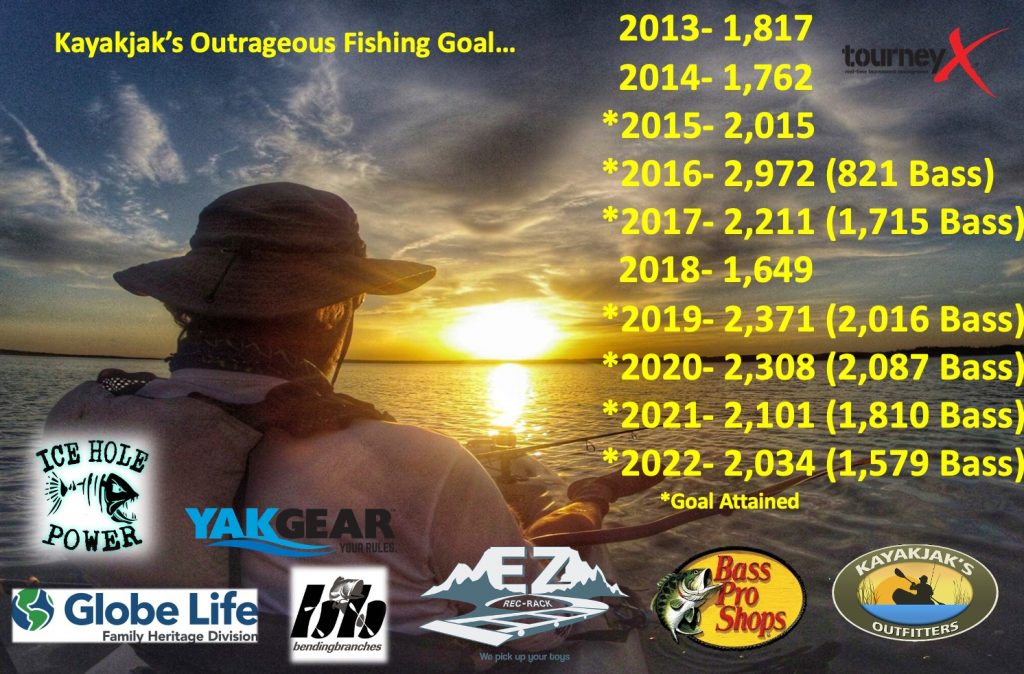
Verdon Lake Fishing Report-March 10, 2021
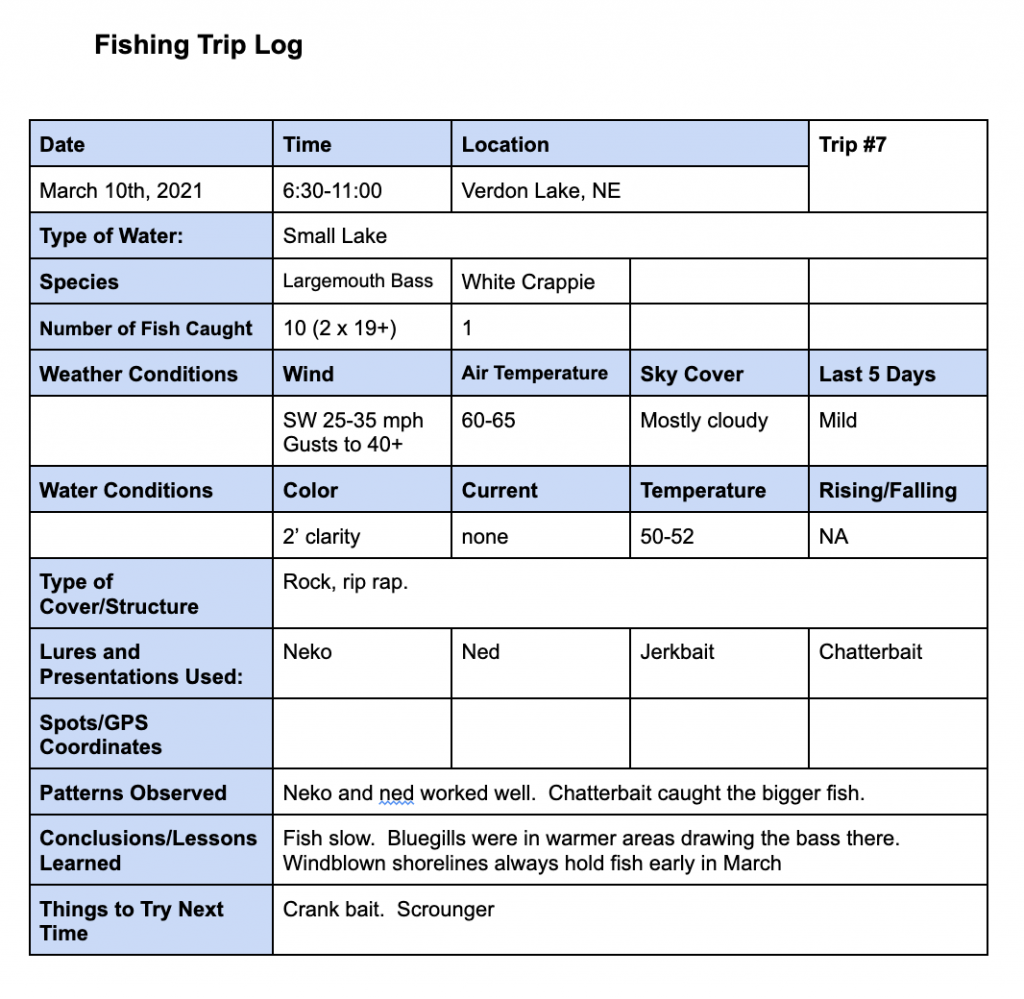
Adult Registration
Kayak Fishing Safety
By Marty Hughes
With kayak fishing interest growing exponentially so enhances the risks involved with this exciting and adventurous sport. Most kayak fishing enthusiasts are fishermen who have made the decision to use the kayak as a resource to get into remote places that hold fish that may have not seen lures recently. Although there is a short learning curve to understanding the basics of fishing from these small plastic vessels there also needs to be the knowledge of preparing for circumstances that could jeopardize a kayak fisherman. Just like anything we do in life, safety is always something that should be considered. Here are some ideas that might help prepare for the unexpected and keep us safe on and off the water.
Years ago kayak fishermen in general came up with the three basic safety rules for kayak fishing which included 1) Dressing to swim, 2) Rigging to float, and 3) Keeping your head in the center of the kayak.
Although very basic in nature there are other things to consider as well including first aid, nutrition, a float plan, navigation, communication, safety gear, and last but not least, the creatures we encounter while pursuing the fish on the water.
Let’s start with the what most call “The 3 Golden Rules” of kayak fishing:
Dress to Swim
What does it mean to “dress to swim?” First and foremost it means wearing your PFD (Personal Floatation Device) at all times on the water. It’s as easy to put on as clicking your seat belt in your vehicle. Wearing a PFD can be a difference maker in whether you survive capsizing or falling out of the kayak in any depth of water. I have worn mine from day one and will never go out without it. Wearing a PFD should be taken very seriously. We’ve all read an article or two about a kayak fisherman who lost their life due to not having a PFD on while fishing from a kayak.
There are numerous styles and types of PFD’s and choosing one that best fits you can be a daunting task in itself. Personally, I prefer a PFD includes pockets, and places to attach my essential accessories which include line cutters, knife, rag, whistle, etc. There are also inflatables which are a bit more pricey and don’t have storage areas on them. Some people say things like “I don’t need to wear a PFD because I’m a great swimmer.” I guess my question would be, “How good of a swimmer are you while unconscious?” Getting hit in the head by an overhead branch that breaks off, or falling while standing in the kayak and hitting your head on the kayak before entering the water are a couple of examples. Some kayak anglers feel that if the PFD is on board and placed within reach that will solve any emergencies. This may not a good measure because if the kayak flips sometimes the wind will blow it away from you and the PFD being secured to the kayak will drift away as well leaving you stranded without a floatation device.
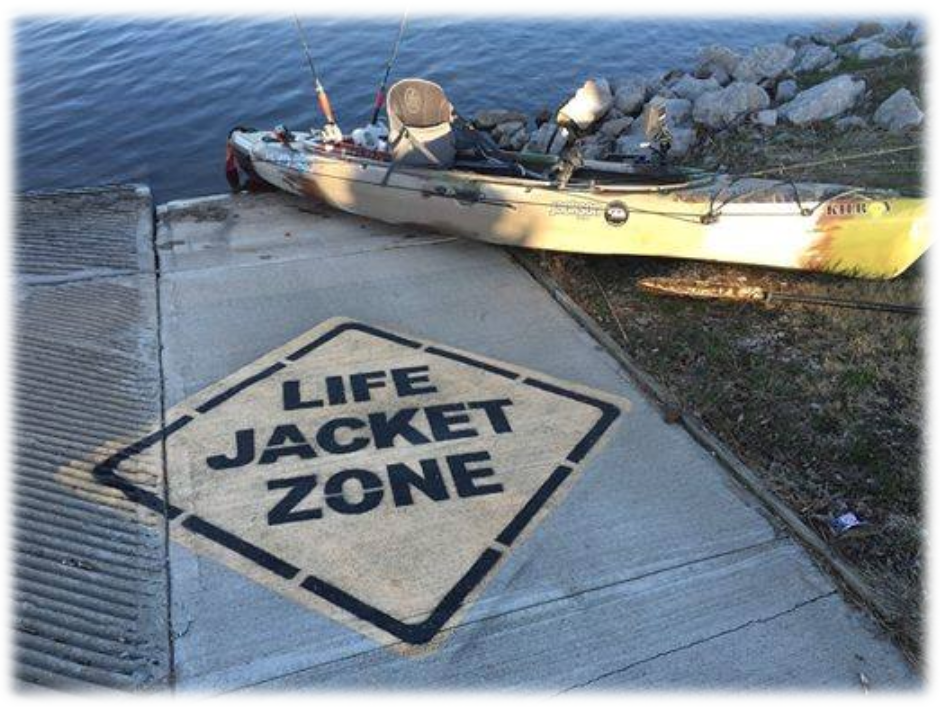
When not in use my PFD is placed over my fish crate in my vehicle so as not to forget it. One great thing about the vest style PFD is that it can keep you warmer by adding another layer in cooler weather and in the water along with protecting you from protruding branches when in thick brush kayak fishing. It’s a good idea to find a PFD that is comfortable as you will be wearing it usually for several hours on the water. The PFD is absolutely an essential piece of equipment you can’t “live” without. I also like to carry a three foot long piece of pool noodle in case someone else needs some extra help. I usually store it in the hull near a hatch.
Wearing lighter clothing that is UV resistant dries quickly and wearing several layers in colder weather is a must. Self wicking clothing can keep you dry as well. There are several brands these days and places like Bass Pro Shops or Cabelas are loaded with this type of clothing on their racks.
Rig To Float
Rigging to float can mean several things. Whatever is not attached or is engineered to float will soon sink to the depths of your favorite fishing hole and may never be retrieved again. It is very important that you attach anything that does not float to your kayak. This is easily done with various leashes and portable fishing mounts. Various companies like Yak-Gear.com have plenty of accessory items that attach to most devices used in kayak fishing. Pliers, camera’s, phones, rods, boxes, you name it can be attached using these products. It is also good to have a bailing device on board to remove water from rain, waves, wakes, etc. if you are paddling a cockpit style kayak with no scupper holes. In some states a bailing device is the law.
Keep Your Head in the Center
Keeping your head at the centerline of the kayak is important to keep your kayak level in the water. When reaching back for accessories, lure boxes, or rods in your crate it is best to reach back like you are taking a baton in a relay race. You want to just turn your torso a bit and your head. It is not wise to reach out and lean to one side of your kayak.
Other valuable safety tips.
Nutrition
We are human and we need fuel to keep us going. It is always wise to store plenty of fluids in your kayak. Many a time I’ve been on the water only to find a kayaker with no water or other sources of hydration on board but I am able to help them out as I always carry extra. I usually pack a lunch and carry other various sources of carbs and protein on board. To stay focused proper nutrition is so important. I’ve also seen kayak fishermen who “crash and burn” just half way through a voyage or tournament due to the lack of proper nutrition.
Float Plan
What is a “float plan?” This procedure could mean several things. First, it always good to tell someone else close to you such as a friend or relative where you are going and when you plan to return. Even if you are traveling with someone else this is a good idea. Some kayakers post a plan on the windshield of their vehicle in an envelope or on a small card. Others post it on social media. You should give information such as how many people are in your group and the color and model of kayak you are paddling. Another type of float plan is preparing for the trip by checking geographic locations and map out where you are going before you voyage out for the day. In any case it is vital to leave someone a message of where you will be in case of emergency.
Be a “weather watcher.”
Weather plays a huge factor in our success on the water. Knowing the latest weather forecast can help you determine if you are even going to go out on the water that day. Also, you will know ahead of time if the weather is going to deteriorate while fishing. As we know, storms can develop in a hurry and wind gusts as high as 60 mph can generate waves that can easily tip a kayak. There are various techniques that can be used in these instances but the most important thing to remember is if you are headed in and the wind is in your face you need to keep the bow turned straight into the wind. If you get sideways disaster is soon ahead. If paddling with the wind, paddle with the waves but again it is very dangerous to be parallel to the waves. Learning how to comfortably paddle in waves will get you to more fishing locations. Practice can make you better at this approach. You should never be on the water during lightning. Get off the water as soon as possible when you know lightning strikes could be near!
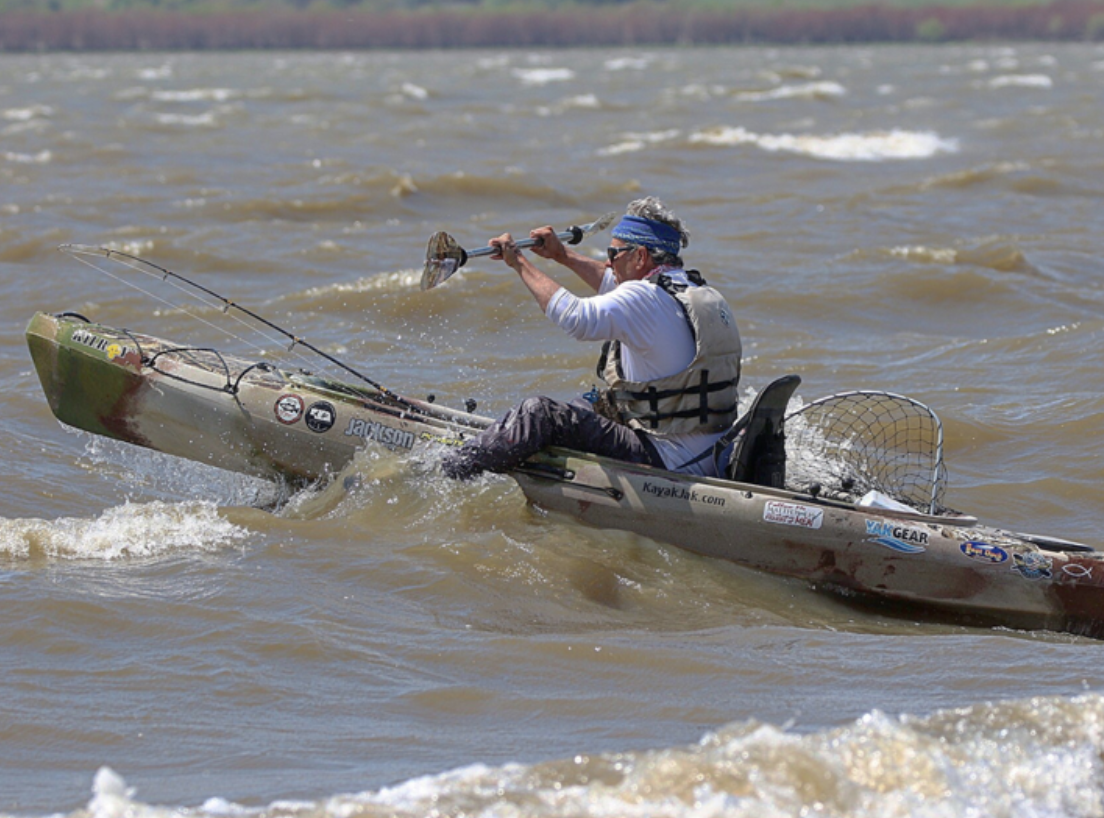
Study your surroundings
Always be aware of your surroundings. I’ve seen other kayak anglers break several of their rods at once because they weren’t paying attention to the overhead trees as they were paddling or they hit a huge stump and ruined their pedal drive. Know the area well and the hazards that might exist while you fish. Always keep an eye out for a motorized boat as they may not see you before it’s too late. There might also be slightly submerged rocks or timber that could capsize you or get you stuck in a hurry! Wearing a headlamp in darkness is also a good idea.
Navigation
There are several methods that can be used for navigation. A compass will work. If you have a sonar unit with the ability to mark waypoints you can create one at the start of your trip in case you are fishing dense trees or fog. A smartphone is also a great way to navigate. Navionics is a nice app to use when finding your direction on large bodies of water.
Communication
Communication can mean many different things including having a phone or VHF radio on board. Most kayakers in the ocean use the VHF radios for safety. You can also communicate by being visible with a flag waving on your vessel and a coast guard approved 360 light at night.
First Aid Kit
A first aid kit is vital! There should always be a first aid kit on board. You never know when you might need a small bandage for a cut or burn. One item of necessity might be a pair of cutting dykes to cut hooks off from lures when one gets stuck in your skin. Hand sanitizer is always good to have on hand as well.
Loading and Unloading your kayak
Oh my back! Loading and unloading is not an easy task at times. A lot depends on the weight of your kayak and where you are loading it. One easy method for me is to use a cart as much as possible when transporting the kayak to the water. When unloading and loading to a trailer, back of a pickup or on the roof of your vehicle a simple method is to load one end at a time. It is half the load and sometimes less. Always use your legs and try not to bend at the waist.
Anchoring
You should always anchor off of your stern or bow of the kayak. An anchor trolley can easily be installed and serve a useful purpose in this area. Be careful not to lean over the side when hoisting an anchor aboard.
Other Safety Items
Be sure to carry a whistle or horn as well. Be sure to have spare batteries as well! It does not good to communicate if the batteries on your device go dead! I always carry a readily accessible knife in case I’ve got to cut something that might wrap dangerously around me or accessories on my kayak.
Creatures of the Water
Kayak fishing means that we are also sharing the water with other creatures and this is their home. Always be aware of the types of creatures you could encounter. Snakes can be a bit scary and alligators have given me an occasional chill down the spine. Most of the time, if you are not bothering them they won’t bother you. Be careful of being near birds nests as well. Birds can attack from just about every direction except below you while on the water if they become distraught from your presence. It’s a good idea to avoid dangerous creatures while on the water.
There is so much more to insure our safety on the water but the information here can at least get you started on your journey without fearing the unknown.
